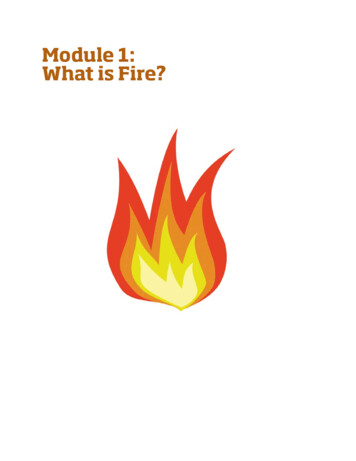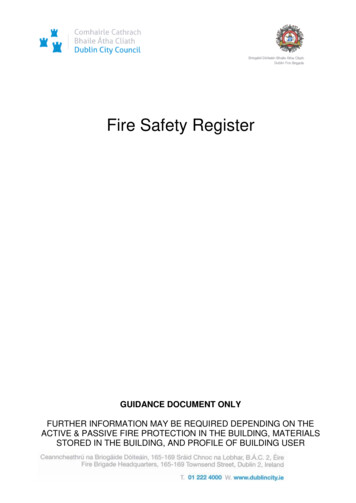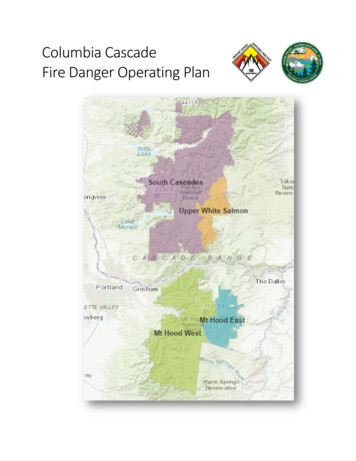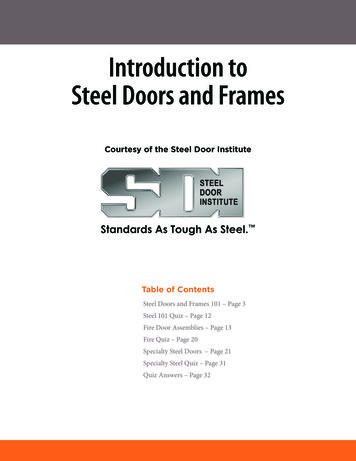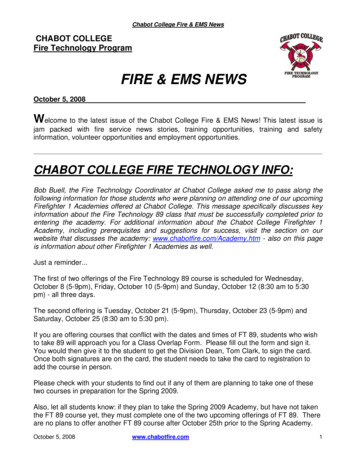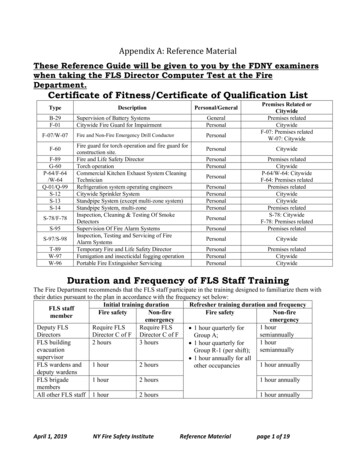
Transcription
Appendix A: Reference MaterialThese Reference Guide will be given to you by the FDNY examinerswhen taking the FLS Director Computer Test at the FireDepartment.Certificate of Fitness/Certificate of Qualification /S-98T-89W-97W-96Personal/GeneralSupervision of Battery SystemsCitywide Fire Guard for ImpairmentGeneralPersonalFire and Non-Fire Emergency Drill ConductorPersonalFire guard for torch operation and fire guard forconstruction site.Fire and Life Safety DirectorTorch operationCommercial Kitchen Exhaust System CleaningTechnicianRefrigeration system operating engineersCitywide Sprinkler SystemStandpipe System (except multi-zone system)Standpipe System, multi-zoneInspection, Cleaning & Testing Of SmokeDetectorsSupervision Of Fire Alarm SystemsInspection, Testing and Servicing of FireAlarm SystemsTemporary Fire and Life Safety DirectorFumigation and insecticidal fogging operationPortable Fire Extinguisher ServicingPremises Related orCitywidePremises relatedCitywideF-07: Premises relatedW-07: emises relatedCitywideP-64/W-64: CitywideF-64: Premises relatedPremises relatedCitywideCitywidePremises relatedS-78: CitywideF-78: Premises relatedPremises mises sonalPersonalPersonalDuration and Frequency of FLS Staff TrainingThe Fire Department recommends that the FLS staff participate in the training designed to familiarize them withtheir duties pursuant to the plan in accordance with the frequency set below:Initial training durationRefresher training duration and frequencyFLS staffFire safetyNon-fireFire safetyNon-firememberemergencyemergency1 hourDeputy FLSRequire FLSRequire FLS 1 hour quarterly forsemiannuallyDirectorsDirector C of F Director C of FGroup A;FLS building2 hours3 hours1 hour 1 hour quarterly forevacuationsemiannuallyGroup R-1 (per shift);supervisor 1 hour annually for allFLS wardens and1 hour2 hours1 hour annuallyother occupanciesdeputy wardensFLS brigade1 hour2 hours1 hour annuallymembersAll other FLS staff 1 hour2 hours1 hour annuallyApril 1, 2019NY Fire Safety InstituteReference Materialpage 1 of 19
Fire alarm systemCertificate of Fitness for fire alarm systemMay be performed by1.2.3.Duties can be performed by C of F HoldersS‐95/F‐89/T‐89S‐97/S‐98Daily visual inspections of fire alarm systemYesYesMaintain the fire alarm log bookYesYesProgram, service, clean, test, repair and/or replace any firealarm system componentsNoYesCertificate of Fitness for smoke detector cleaning and testingMay be performed byDuties can be performed by C of F Holders1.2.3.3.Smoke detector visual inspectionSmoke detector inspection, testing and cleaningSmoke detector maintenanceProgram, service, clean, test, repair and/orreplace fire alarm componentsS‐95/F‐89/T‐89S‐78/ sVisual Inspection and Testing Frequencies of Fire Alarm Systems1. Visual inspection frequencies of each fire alarm componentComponentsWeeklyControl equipment: fire alarm systems UNMONITORED for alarm, supervisory and trouble signals(including fuses, interfaced equipment, lamps and LEDs, primary (main) power supply)MonthlyBatteries: Lead-acidBatteries: Primary (dry cell)QuarterlyInitiating devices: Radiant energy fire detectorsInitiating devices: Supervisory signal devicesInitiating devices: Waterflow devicesSemiannuallyBatteries: Nickel-cadmiumBatteries: Sealed lead-acidFire alarm control unit trouble signalsIn-building fire emergency voice/alarm communications equipmentRemote annunciatorsInitiating devices:- Air sampling- Duct detectors- Electromechanical releasing- Fire extinguishing system(s) or suppression system(s) switchesApril 1, 2019NY Fire Safety InstituteReference Materialpage 2 of 19
1. Visual inspection frequencies of each fire alarm componentComponents- Manual fire alarm boxes- Heat detectors- Smoke detectors (excluding one- and two-family dwellings)Supervising Station Fire Alarm Systems- Transmitters: DACT- Transmitters: DART- Transmitters: McCulloh- Transmitters: RATSpecial proceduresPublic emergency alarm reporting system transmission equipment-Publicly accessible alarm box-Master box- manual operationMass notification system, NON-SUPERVISED systems installed prior to adoption of the NFPA 72,2010 edition-Control equipment: Fuses-Control equipment: Interfaces-Control equipment: Lamp/LED-Control equipment: Primary (main) power supply-Secondary power batteries: Lead-acid-Secondary power batteries: Nickel-cadmium-Secondary power batteries: Primary (dry-cell)-Secondary power batteries: Sealed lead-acid-Initiating devices-Notification appliancesGuard’s tour equipmentSemiannuallyCombination systems : Fire extinguisher electronic monitoring device/systemsCombination systems: Carbon monoxide detectors/systemsInterface equipmentAlarm notification appliances-supervisedExit marking audible notification appliancesAnnuallyControl equipment: fire alarm systems MONITORED for alarm, supervisory, and trouble signals(including fuses, interfaced equipment, lamps and LEDs, primary (main) power supply)Fiber-optic cable connectionsPublic emergency alarm reporting system transmission equipment-Auxiliary box-Master box- auxiliary operationMass notification system, SUPERVISED-Control equipment: Fuses-Control equipment: Interfaces-Control equipment: Lamp/LED-Control equipment: Primary (main) power supply-Secondary power batteries: Lead-acid-Secondary power batteries: Nickel-cadmium-Secondary power batteries: Primary (dry-cell)April 1, 2019NY Fire Safety InstituteReference Materialpage 3 of 19
1. Visual inspection frequencies of each fire alarm componentComponents-Secondary power batteries: Sealed lead-acid-Initiating devices-Notification appliancesMass notification system: AntennaMass notification system: Transceivers2. Test frequencies of each fire alarm componentsComponentsDailyPublic emergency alarm reporting systems: Power supply: Wired system-voltage testsWeeklyPublic emergency alarm reporting systems: Engine-driven generatorMonthlyBatteries-fire alarm systems: Primary type (dry cell)-Age testQuarterlyControl equipment: building systems NOT connected to a supervising station (including Functions, fuses,interfaced equipment, lamps and LEDs, primary (main) power supply, and transponders)Public emergency alarm reporting systems: Power supply-Lead-acid type batteries- Discharge test(2 hours)-Lead-acid type batteries- Load voltage test-Nickel-cadmium type batteries- Load voltage test-Sealed lead-acid type batteries- Load voltage testInitiating devices: Supervisory signal devicesPressure supervisory indicating devices-Water level supervisory indicating devices-Water temperature supervisory indicating devices-Room temperature supervisory indicating devices-Other suppression system supervisory indicating devicesSemiannuallyBatteries-fire alarm systems:- Lead-acid type- Discharge test (30 minutes)- Lead-acid type- Load voltage test- Lead-acid type- Specific gravity- Nickel-cadmium type- Load voltage test- Sealed lead-acid type- Load voltage testPublic emergency alarm reporting systems: Power supply: Lead-acid type batteries- Specific gravityInitiating devices:- Radiant energy fire detectors- Supervisory signal devices: Valve supervisory switches- Waterflow devicesPublic emergency alarm reporting system transmission equipment:- Public accessible alarm box- Master box-manual operationApril 1, 2019NY Fire Safety InstituteReference Materialpage 4 of 19
2. Test frequencies of each fire alarm componentsComponentsMass notification system, NON-SUPERVISED systems installed prior to adoption of the NFPA 72, 2010edition-Control unit functions and no diagnostic failures are indicated-Audible/visible functional test-Secondary power-Verify content of prerecorded messages-Verify activation of correct prerecorded message based on a selected event-Verify activation of correct prerecorded message based on a targeted event-Verify control unit security mechanism is functionalAnnuallyControl equipment: building systems connected to a supervising station (including Functions, fuses,interfaced equipment, lamps and LEDs, primary (main) power supply, and transponders)Batteries- Fire alarm systems:- Lead-acid type- Charger test (replace battery as needed)- Nickel-cadmium type- Charger test (replace battery as needed)- Nickel-cadmium type- Discharge test (30 minutes)- Sealed lead-acid type- Charger test (replace battery within 5 years after manufacture or morefrequently as needed)- Sealed lead-acid type- Discharge test (30 minutes)Public emergency alarm reporting systems: Power supply-Lead-acid type batteries-Charger test (replace battery as needed)-Nickel-cadmium type batteries-Charger test (replace battery as needed)-Nickel-cadmium type batteries-Discharge test (2 hours)-Sealed lead-acid type batteries-Charger test (replace battery within 5 years after manufacture ormore frequently if needed)-Sealed lead-acid type batteries-Discharge test (2 hours)Fiber-optic cable powerControl unit trouble signalsIn-building fire emergency voice/alarm communications equipmentRemote annunciatorsInitiating devices:- Duct detectors- Electromechanical releasing- Fire extinguishing system(s) or suppression system(s) switches- Fire-gas and other detectors- Manual fire alarm boxes- Heat detectors- System smoke detectors- functional test- Single- and multiple- station heat alarms- Single- and multiple- station smoke alarms (in other than one- and two-family dwellings)- Other supervisory initiating devicesGuard’s tour equipmentApril 1, 2019NY Fire Safety InstituteReference Materialpage 5 of 19
2. Test frequencies of each fire alarm componentsComponentsCombination systems: Fire extinguisher electronic monitoring device/ systemsCombination systems: Carbon monoxide detectors/systemsInterface equipment and emergency control functions (i.e., fan control, smoke damper operation,elevator recall, elevator power shutdown, door holder release, shutter release, fail-safe system, etc.)Special hazard equipmentAlarm notification appliances:- Audible devices- Audible textual notification appliances- Visible devicesExit marking notification appliancesPublic emergency alarm reporting system transmission equipment:- Auxiliary box- Master box-Auxiliary operationSupervising station alarm systems-transmittersAnnuallySpecial proceduresMass notification system- protected premises, SUPERVISEDControl unit functions and no diagnostic failures are indicatedAudible/visible functional testSecondary powerVerify content of prerecorded messagesVerify activation of correct prerecorded message based on a selected eventVerify activation of correct prerecorded message based on a targeted eventVerify control unit security mechanism is functionalMass notification system- wide-areaControl unit functions and no diagnostic failures are indicatedControl unit resetControl unit securityAudible/visible functional testSoftware backupSecondary powerAntennaTransceiversVerify content of prerecorded messagesVerify activation of correct prerecorded message based on a selected eventVerify activation of correct prerecorded message based on a targeted eventVerify control unit security mechanism is functionalApril 1, 2019NY Fire Safety InstituteReference Materialpage 6 of 19
Smoke detectorsAll smoke detectors connected to a defined fire alarm system must bea. cleaned at least once every 6 months, except for analog (intelligent) smoke detectors, whichmust be cleaned no later than one week from receipt of an indication of the need for cleaning.b. tested for smoke entry at least once a year.c. tested for sensitivity at least once a year, except for analog (intelligent) smoke detectors, whichmust be tested for sensitivity no later than one week from receipt of an indication of the need forsuch testing.Sprinkler systemsSpare sprinkler headsA stock of spare sprinklers (not less than 6) must be kept on the premise where the temperature does not exceed100 Degrees F and must include all types and ratings installed in the protected facility and provided as follows:1-300 sprinklers six.301 - 1000 sprinklers twelve.Over 1000 sprinklers twenty-four.Individuals authorized to perform tasksThere are certain periodic visual inspections, maintenance, and tests required by the Fire Code that the S-12/S-15Certificate of Fitness holder may perform, and some that they cannot without additional qualifications (refer to S12/S-15 FDNY Certificate of Fitness booklet). The table below provides details of the qualifications required forindividuals perform various tasks:Holding S12/S-15 onlyQ-01holding S12/S-15YesYesMasterPlumberholding S12/S-15YesYesMaster FireSuppression PipingContractor holdingS-12/S-15YesYesVisual inspectionsPerform limited maintenance and test of sprinklersystem components (refer to the S-12/S-15 bookletfor the detail)YesNoTest, maintain and repair/replace all sprinklersystems components, but limited to residentialoccupancies 30 sprinkler heads or less without abooster pump.Test, maintain and repair/replace all sprinklersystems componentsNoNoYesYesNoNoNoYesThe FLS Directors with S-12/S-15 C of F are only authorized to conduct visual inspections of a standpipesystem.April 1, 2019NY Fire Safety InstituteReference Materialpage 7 of 19
Test Frequency of Sprinkler SystemsC of FEngineerCertificate of Fitness for (S‐12) or (S‐15).Refrigeration Operating Engineer (Q‐01 or Q‐99), NYC High Pressure Operating Engineer, NYS High Pressure OperatingEngineer with S‐12 C of F(For employees of a single or multiple properties under common ownership employed by the same buildingowner/management company)MFSPCMaster Fire Suppression Piping Contractor License (A or B) with S‐12 or S‐15 C of F.MPMaster Plumber License (MP) with S‐12 or S‐15 C of F.1 Limitedto residential occupancies 30 sprinkler heads or less without booster pump.2S‐95 Supervision for Fire alarm Systems & other related systems.3Record must be maintained to be checked annually.4Must be performed once annually by licensed contractor.* Foam‐Water Sprinkler Systems ONLY.** Water Spray Fixed Systems ONLY.Test frequency requirements for sprinkler system componentsMay be performed byComponentsC of FEngineerMFSPCMP1A. Sprinkler SystemsQUARTERLY (4)Alarm Deviceswater motor gongWater Spray system NoYesYesYes1NoYesYesYes1SEMIANNUALLY (2)Alarm Devices (Vane type water flow devices)Pressure Switch TypeANNUALLY (1)Antifreeze solutionFlushing**Complete foam‐water system(s)*Foam‐water solution*5 YEARSGauges ‐ Remove & send for calibration test or replace asrequiredSprinklers ‐ Remove send for extra high temperature test andreplace as required10 years & every 10 yrs. thereafterSprinklers ‐ Dry type20 years & every 10 yrs. thereafterSprinklers – fast response and residential50 years & every 10 years afterSprinklers (Standard Response)B. Fire, Booster and Special Service PumpsWEEKLY (52)Pump operation ‐ No‐flow conditionDiesel Engine systemtank float switchSolenoids valve operationApril 1, 2019NY Fire Safety InstituteReference Materialpage 8 of 19
MONTHLY Yes1NoNoYesNoOperate emergency manual starting means (withoutpower)NoNoYesNoExcessive back pressureTank vents and overflow piping es1Fire pump – Electric pump (minimum of 10 minutes)Electrical system2Isolating switch & circuit breakerBattery systemSpecific gravity or state of chargeSEMIANNUALLY (2)Electrical system2Diesel Engine SystemOperating manual starting means (electrical)Cooling systemAntifreeze protection levelFuelTank float switchSolenoids valve operationElectrical systemOperation of safeties and alarmsANNUALLY (1)Pump operation ‐ Flow conditionElectrical system2Trip circuit breaker (if mechanism provided)Exhaust systemDiesel Engine SystemC. Water Storage TankMONTHLY (12)Temperature alarms (cold weather)High temperature limit switches (cold weather)SEMIANNUALLY (2)Water level alarms5 YEARSLevel indicatorsPressure gaugesD. Valve and Valve ComponentQUARTERLY (4)Main drain (sole water supply is through abackflow preventer and/or pressure reducing valves)Water‐Flow Alarms (pertaining to dry valves, pre‐action, and deluge valves)Foam concentrate strainer(s)*Pre‐action and deluge valvesDry pipe valves and Quick OpeningdevicesPriming waterLow/high air pressure alarmPriming waterLow/high air pressure alarmQuick‐opening devicesSEMIANNUALLY (2)Control Valves Tamper SwitchSupervisory AlarmNoYes4YesYes1Water flow alarmsVane‐type and pressure Switch‐type sYes1YesANNUALLY (1)Main drainPreaction and deluge valvesFull flowDry pipe valves and Quick Opening devicesTrip testControl ValvesPositionOperationPressure reducing and Relief valvesCirculation reliefPressure relief valvesBackflow prevention Assemblies/Forward flow testProportioning system(s)‐all*April 1, 2019NY Fire Safety InstituteReference Materialpage 9 of 19
Manual actuation device(s)*Backflow 1YesNoNoYesYesNoNoYesYes13 YEARSDry pipe valves and quick opening devicesFull flow trip testPre‐action systemsFor air leakage5 YEARSHydrostatic TestPressure reducing & Relief valvesSprinkler systemsHose connectionsHose racksStandpipe systemsIndividuals authorized to perform tasksA multi-zone standpipe system must be continuously under the supervision of an S-14 Certificate of Fitnessholder. In other words, if your building has multi-zone standpipe system, there must be at least one S-14 C of Fholder that could be continuously supervising this system.The FLS Directors with S-13/S-14 C of F are only authorized to conduct visual inspections of a standpipesystem.The sole FLS Director (without holding an S-13/S-14 C of F) C of F is not authorized to conduct requiredinspections of a standpipe system; however, the FLS Director must ensure that the standpipe systems are inspected,test and maintained as required frequency by the proper C of F or license holder.The S-13/S-14 C of F holders with different qualifications are permitted to carry different level of responsibilitiesin inspecting, testing and maintaining the standpipe systems:HoldingS‐13 onlyQ‐01holdingS‐13Master Plumberholding S‐13Master FireSuppression PipingContractor holdingS‐13Visual inspectionsYesYesYesYesPerform limited maintenance and test ofstandpipe system components (refer to the S‐13/S‐14 booklet for detail)NoYesYesYesTest, maintain and repair/replace all standpipesystems that are NOT combined with sprinklersystemsNoNoYesYesTest, maintain and repair/replace all standpipesystems components that are combined withsprinkler systemsNoNoNoYesStandpipe system (without multi‐zone)HoldingS‐14 onlyQ‐01 holdingS‐14Visual inspectionsYesYesPerform limited maintenance and test of standpipe system components (refer tothe S‐13/S‐14 booklet for detail)NoYesTest, maintain and repair/replace all standpipe systems that are NOT combinedwith sprinkler systemsNoNoTest, maintain and repair/replace all standpipe systems components that arecombined with sprinkler systemsNoNoMulti‐zone standpipe systemApril 1, 2019NY Fire Safety InstituteReference Materialpage 10 of 19
Test Frequency of Standpipe SystemsC of FEngineerCertificate of Fitness S‐13 City Wide Standpipe System.Refrigeration Operating Engineer (Q‐01 & Q‐99), NYC High Pressure Operating Engineer, NYSHigh Pressure Operating Engineer with S‐13 C of F(For employees of a single or multiple properties under common ownershipemployed by the same building owner/management company)MFSPCMaster Fire Suppression Piping Contractor License (A or B) with S‐13 C of F.MPMaster Plumber License (MP) with S‐13 C of F.1 Must have an S‐12 or S‐15 Certificate.2 S‐95 Supervision for Fire Alarm Systems & other related systems.3 Follow testing requirement.4 Record must be maintained to be checked annually.5 Must be performed once annually by licensed contractor.Test frequency requirements for standpipe system componentsComponentsMay be performed byC of YesYesYesYesYesYesYesYesYesYesYesYesYesFrequencyA. Standpipe SystemsQUARTERLY (4)Water flow alarmsYesSupervisory devicesYesSEMIANNUALLY (2)Alarm Devices (Vane Type and Pressure Type water flowYesdevices)5 YEARSGauges ‐ Remove and send for calibration test or replaceNoas requiredB. Fire, Booster and Special Service PumpsWEEKLY (52)Diesel Pump operation ‐ No‐flow conditionNoDiesel EngineSolenoids valve operationNosystemFuel Tank float switchSolenoids valve operationMONTHLY (1)Electric Fire pump ‐ (minimum of 10 minutes)NoElectrical system 2Isolating switch & circuit breakerNoBattery systemSpecific gravity or state of chargeB. Fire, Booster and Special Service PumpsSEMIANNUALLY (2)Electrical system 2Operate manual starting meansNo(electrical)Diesel EngineCoolingAntifreezeNoSystemsystemprotection levelAlarm DevicesOperation ofsafeties and alarmsANNUALLY (1)Pump operation ‐ Flow conditionNoElectrical system 2Trip circuit breaker (if mechanismNoprovided)Operate emergency manualstarting means (without temApril 1, 2019NY Fire Safety InstituteNoNoReference Materialpage 11 of 19
Exhaust systemExcessive back pressureNoDiesel EngineTank vents and overflow pipingNoSystemunobstructedC. Water Storage TankMONTHLY (12)Temperature alarms (cold weather)NoHigh temperature limit switches (whenever the heatingNosystem is in service)SEMIANNUALLY (2)Water level alarmsNo5 YEARSLevel indicatorsNoPressure gaugesNoD. Valve and Valve ComponentQUARTERLY (4)Main drain (where the sole water supply is through aNobackflow preventer and/or pressure reducing valves)Dry pipe valves andPriming waterNoquick openingLow air pressure alarmdevicesQuick‐opening devicesControl ValvesTamper SwitchSupervisory AlarmHose Nozzle (NFPA 1962)Hose Storage device, racks (NFPA 1962)Standpipe – hose valve (Class I and Class III)Main drainD. Valve and Valve ComponentDry pipe valves andQuick openingdevicesControl ValvesTrip testPositionOperationPressure reducingCirculation reliefand Relief valvesPressure relief valvesBackflow prevention AssembliesHose 1962Dry pipe valves andFull flow trip testquick openingdevicesPressure reducing valve flow LY (2)NoYes5YesYesANNUALLY LLY (1)NoNoYesYesNoNoYesYesNoNoYesYesNo3 es4YesYesYesYesYesYesYesYesNo5 YEARSHoseNoHydrostatic TestNoStandpipe system full flow testNoGauges ‐ Remove and send for calibration test or replaceNoas requiredApril 1, 2019NY Fire Safety InstituteReference Materialpage 12 of 19
Non-water fire extinguishing systems summary tableSystemsCommonly found in/withDry chemical fireextinguishingsystemsWet chemical fireextinguishingsystemsFoam systemsflammable liquid storage roomsand at motor fuel dispensingareas.commercial cooking systemCarbon dioxide fireextinguishing systemflammable liquid storage roomsand at motor fuel dispensingareas.IT systems, data storage roomsand manufacturing equipment, orirreplaceable itemscommercial cooking systemClean agent fireextinguishingsystemsHalon fireextinguishingsystemsWater mist uiredrequiredrequired to beconducted bya S-15 COFholderrequiredrequiredrequiredcomputer rooms or otherenergized electrical equipmentareasTest, service and maintenanceQualifiedMinimum frequencypersonnelrequirementsemiannualsemiannualA licensedmaster firesuppressionpipingcontractorproperly trainedand havingknowledge ofthe installation,operation andmaintenance ofthe emiannualannualSmoke control systemInspection, Maintenance and TestingFire Code requires that smoke control systems be maintained in good working order. It requires a writtenmaintenance program, including periodic inspection and testing, to be established and implemented immediatelyupon installation of the smoke control system. Operational testing of the smoke control system must include allof the system’s components including initiating devices, fans, dampers, controls, doors and windows.Frequency Dedicated smoke control systems:o Non-dedicated smoke control systems:o April 1, 2019must be tested semiannuallymust be tested annually.Post –fire smoke purge systems:omust be tested periodicallyoperiodic inspectionomaintained according to manufacturers’ recommendations.NY Fire Safety InstituteReference Materialpage 13 of 19
Emergency power SystemIndividuals authorized to perform tasksFire Code requires that the inspection, testing and other maintenance of emergency power systems be conductedunder the supervision of a person having one of the following qualifications: A person holding a Certificate of Fitness as a Fire and Life Safety Director. A person holding a Q-01 Certificate of Qualification. An electrician licensed by the Department of Buildings. An electrician holding a special license issued by the Department of Buildings. A person holding a stationary engineer license, or high-pressure boiler operating engineer’s license,issued by the Department of Buildings. A registered design professional.Periodic inspection and testing requirementsNFPA Standard 110Chapter 8 of NFPA Standard 110 includes requirements for the periodic inspection, testing and othermaintenance of emergency power systems supplied by emergency generators. Emergency power systemssubject to compliance with the requirements of NFPA Standard 110, as modified by FC Appendix B mustbe maintained as follows: Storage batteries, including electrolyte levels or battery voltage, must be inspected weekly andmaintained in full compliance with the manufacturer’s specifications. Lead- acid batteries mustinclude the monthly testing and recording of electrolyte specific gravity. Emergency power systems, including all related components, must be inspected weekly andexercised under load monthly. Emergency generator sets must be tested monthly for a minimum of 30 minutes under operatingtemperature conditions and at not less than 30 percent of the emergency power system nameplatekilowatt rating, or under loading that maintains the minimum exhaust gas temperatures asrecommended by the manufacturer. Instructions must be provided for safe manual transfer in theevent automatic transfer switches malfunction. Diesel-powered emergency power system installations that do not meet the requirements ofgenerator set monthly exercise as noted above must be tested monthly with the availableemergency power system load and exercised annually with supplemental loads at 25 percent ofnameplate rating for 30 minutes, followed by 50 percent of nameplate rating for 30 minutes,followed by 75 percent of nameplate rating for 60 minutes, for a total of 2 continuous hours. Transfer switches must be tested semiannually. The semiannually test of a transfer switch mustconsist of electrically operating the transfer switch from the standard position to the alternateposition and then returning back to the standard position. Level 1 emergency power systems must be tested every 3 years for at least 4 hours under itsrunning load. A full facility power outage is not intended for this test, but is recommended wherea facility power outage has not occurred within the last 36 months. Emergency power systems must be maintained to ensure to a reasonable degree that the systemis capable of supplying service within the time specified for both the type and the class. TheApril 1, 2019NY Fire Safety InstituteReference Materialpage 14 of 19
maintenance procedure and frequency should conform to the manufacturer’s recommendations.In the absence of such recommendations, Figure A.8.3.1(a) of NFPA Standard 110 suggestsperiodic (weekly, monthly, quarterly, semiannually and annually) visual inspection, checking,changing components, cleaning and testing of the following:o Fuel.o Lubrication system.o Cooling system.o Exhaust system.o Battery system.o Electrical system.o Prime mover.o Generator.o General conditions of emergency power systems (any unusual condition of vibration,leakage, noise, temperature or deterioration), and service room or housing housekeeping.o Restore systems to automatic operation condition.NFPA Standard 111Stored electrical energy emergency power systems subject to compliance with the requirements of NFPAStandard 111 must be maintained as follows: Equipment must be inspected monthly and tested quarterly under connected load for a minimumof 5 minutes. The monthly inspection must include the following:o Battery and associated charger/control equipment must be checked to verify that they are ina clean and satisfactory condition.o Battery electrolyte levels, individual cell voltages and specific gravity must be checked.o Conditions of the plates and sediment of free-electrolyte, lead-acid batteries in transparentcontainers must be checked.o A load test must be performed and the output voltage, the battery voltage, and the durationof the test must be recorded at the beginning and end of the test for each battery set.o All indicator lamps, meters, and controls must be checked to verify that they are operatingcorrectly. Stored emergency power systems must be checked annually at full load for time duration asspecified in NFPA Standard 111. Transfer switches must be tested semiannually. A regular maintenance and testing program must be established. The
Citywide B-29 Supervision of Battery Systems General Premises related F-01 Citywide Fire Guard for Impairment Personal Citywide F-07/W-07 Fire and Non-Fire Emergency Drill Conductor Personal F-07: Premises related W-07: Citywide F-60 Fire guard for torch operation and fire guard for construction site. Personal Citywide



